Tour Armenia’s Enduring Soviet-Era Architecture
Armenia’s unique flavor of Soviet Modernism combined socialist design ideals, classical stonework and pink volcanic rock
/https://tf-cmsv2-smithsonianmag-media.s3.amazonaws.com/filer/d4/5f/d45fcafb-6e13-4ee7-b4f9-15dabc809d1f/istock-1029697214.jpg)
From 1920 through 1991, Armenia was a part of the Soviet Union. Known mostly as the Armenian Soviet Socialist Republic (in 1990 it was renamed the Republic of Armenia), it was a place where industrialization flourished, and utilitarian Soviet-style architecture reigned. Now more than 25 years since the U.S.S.R.'s dismantling, much of that architecture remains—especially in Yerevan, the country's vibrant capital. Each of the U.S.S.R.'s national republics were allowed to interpret Stalinist and other Soviet-styles of architecture in their own way, and what's especially alluring about Armenia's Soviet architecture is its local feel: incorporating elements like the classical Armenian style and the locally quarried volcanic stone known as tuff that gives Yerevan its nickname, “the Pink City.” Despite their often mandated origins, many of these structures have grown to become especially beloved over time. Here are seven of the most celebrated:
Central Railway Station, Yerevan
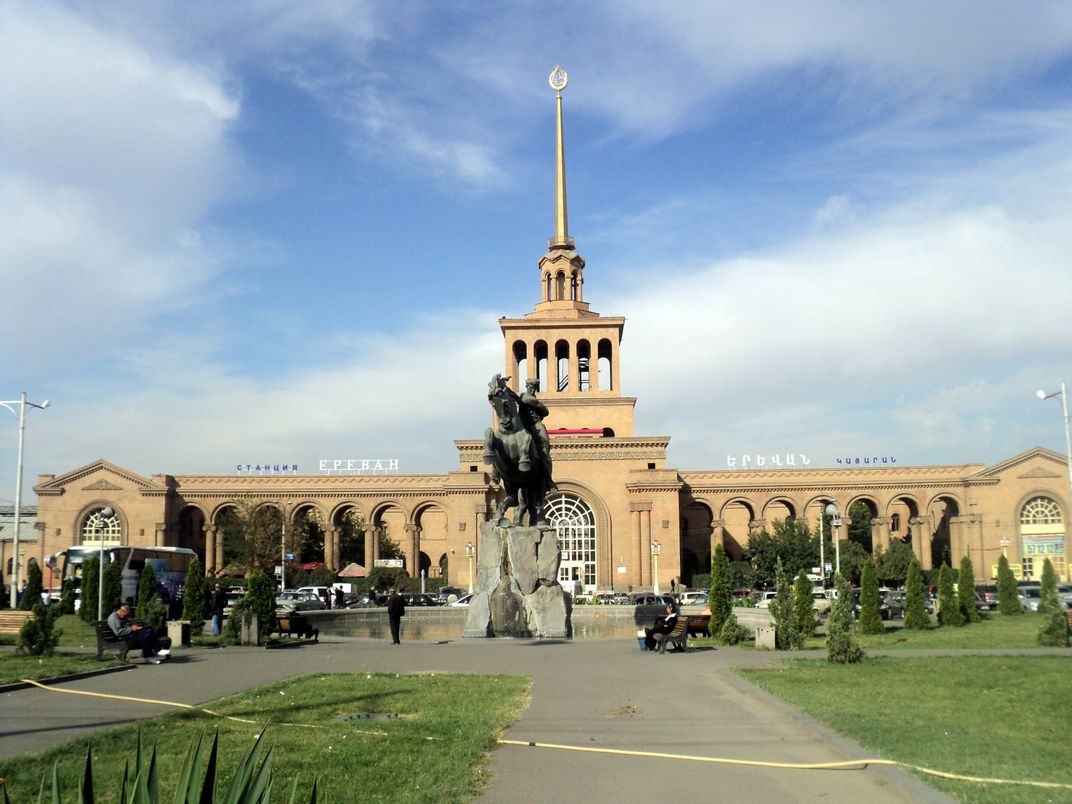
Soviet-era transit stations remain strewn throughout Armenia, but one of the country's finest examples is Yerevan Railway Station, located in the capital city's Erebuni district, south of downtown. Designed by Armenian architect E. Tigranyan, the now iconic structure opened in 1956 and is still in operation: an architectural blend of Socialist Realism—showcasing the glories of Communism—Neo-classical and traditional Armenian-style constructed in pink tufa stone. One of the station's most intriguing Soviet-era features is its Soviet-Armenian coat of arms—a five-point Soviet star above a likeness of Mount Ararat, sacred to Armenians—atop an exterior spire towering above its central entrance. It's one of the few places in the country this coat of arms still remains.
Yerevan Railway Station presides over Sasun Square, which also features a copper-made statue of David of Sasun on horseback—the hero of Armenia's national epic, Daredevils of Sasun—erected in 1959. The U.S.S.R. issued both stamps and coins depicting its image.
Moscow Cinema, Yerevan
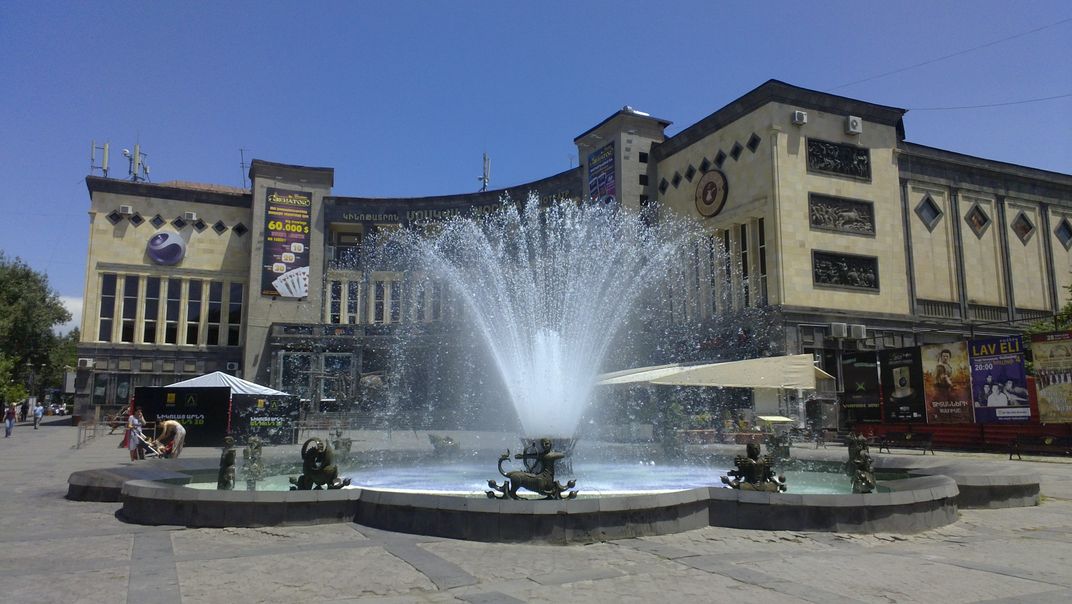
In the early years of Soviet reign, Armenia's governing body destroyed many of the country's churches and shrines in efforts to wipe-out organized religion and make way for more secular cultural institutions, including cinemas. One such example: Yerevan's 5th century St. Peter and Paul Church, which was demolished and replaced by the Moscow Cinema, a 1936 movie palace still in operation today. Originally built in the constructivist-style—a form of modern Soviet architecture which was approaching its tail end—architects Spartak Kndeghtsyan and Telman Gevorgyan added a Functionalist-style open-air hall in the 1960s, using concrete forms to transform a backyard between two buildings into one of the city's most popular public gathering spaces. In 1983, a facade adorned with scenes from famous Soviet-Armenian movies like Pepo—the theater's opening film—was also added.
When in 2010, the Armenian Government proposed an idea to demolish the open air hall and rebuild St. Peter and Paul Church in its former location, it was met with immediate backlash. More than 6,000 people protested as part of a Facebook group called “SAVE Cinema Moscow Open-Air Hall,” reclaiming the now public space as their own.
The Cascade and Mother Armenia, Yerevan
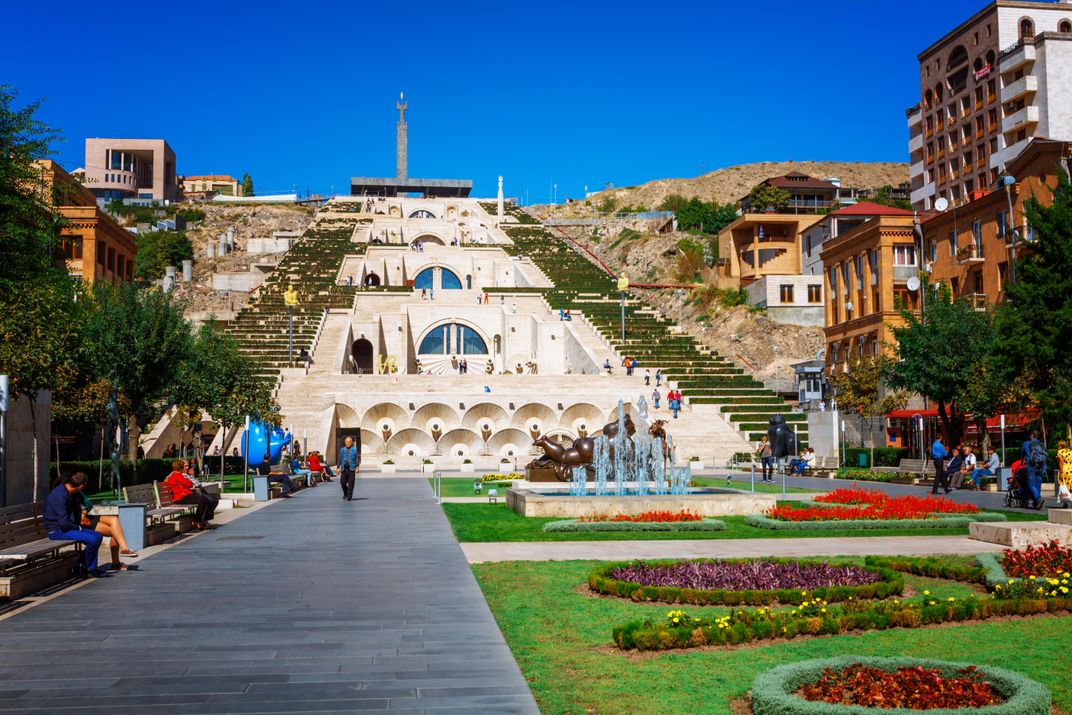
It is 572 limestone steps from the modernist sculpture garden at the base of Yerevan's stark white Cascade to its top. The two staircases, interspersed with layers of greenery, fountains and waterfalls, link the city's downtown with its upper Monument neighborhood, which offers stunning views of the city and Mt. Ararat. Yerevan's chief architect Alexander Tamanyan first came up with the idea for this sloping hillside monument in the early 20th century, though it didn't come to fruition until the 1970s, when Armenian-Soviet architect Jim Torosyan revived the concept and added impressive features like the exterior stairway and—inside the monument—a series of escalators and courtyards. Though partially completed in the early 1980s, the Art Deco structure stood neglected for years after the Armenian earthquake of 1988, followed by the 1991 Soviet dissolution. Since then this odd Soviet-era masterpiece has been completely renovated and revitalized, an Armenian version of the ancient Hanging Gardens of Babylon, complete with its own modern art museum, the Cafesjian Museum of Art.
A bit further on, at the top of the Cascade, lies Victory Park and its custodian, Mother Armenia. This female epitome of “peace through strength” stands 170-feet-tall atop a huge basalt pedestal—one that was originally built for a colossal statue of Soviet leader Joseph Stalin, erected in 1950 as a victory memorial for WWII. After Stalin's death and the denouncement of his dictatorial regime, his likeness was removed—and in 1967—replaced with the hammered copper figure of Mother Armenia.
Despite creating the pedestal for the Stalin monument, architect Rafayel Israyelian still designed it as a simple three-nave Armenian basilica, rather than in the Soviet-style. Years later he admitted doing this intentionally, saying “the glory of dictators is temporary.”
Writers' Resort, Sevan
Sevan Writers’ Resort overlooks the shores of eastern Armenia's Lake Sevan—a popular holiday spot that's also the largest body of water in the entire Caucasus region. Unique among the area's resort hotels and castle ruins, this distinctly Soviet-style retreat for members and visitors of the Writers’ Union of the Armenian Soviet Socialist Republic—which attracted literary luminaries like Russian poet Osip Mandelstam and French novelist and philosopher Jean-Paul Sartre—has in recent years become an icon of Soviet Modernism, appearing on everything from a book cover to exhibition posters for a related Vienna exhibition.
What's especially unique is its two stand-alone structures—one exceedingly more photogenic than the other—each designed years apart but by the same architect. Armenian avant-garde architects Gevorg Kochar and Mikael Mazmanyan designed the resort's original guesthouse in the early 1930s, a four-story boxy structure with curved balconies and lake views, which engaged with the surrounding environment in a functional way. Once completing the project, both men were exiled to Siberia for 15 years under Stalin's rule and not released until after his death, at which point they were considered “rehabilitated.”
Back at the Writers' Resort, Kochar then went to work on his dream project: a neighboring canteen-wing for the complex that is completely in-tune with the Soviet Space Age design of its time. The cantilevered, futuristic structure, completed in 1963, juts out over the hillside on a center concrete leg and features a staggered array of curved glass windows that provide panoramic views over Lake Sevan.
The Getty Foundation is currently overseeing the resort's restoration, which will include a conference center and restaurant. Both writers and non-writers can still book a room in the interim.
Zvartnots Tower, Yerevan
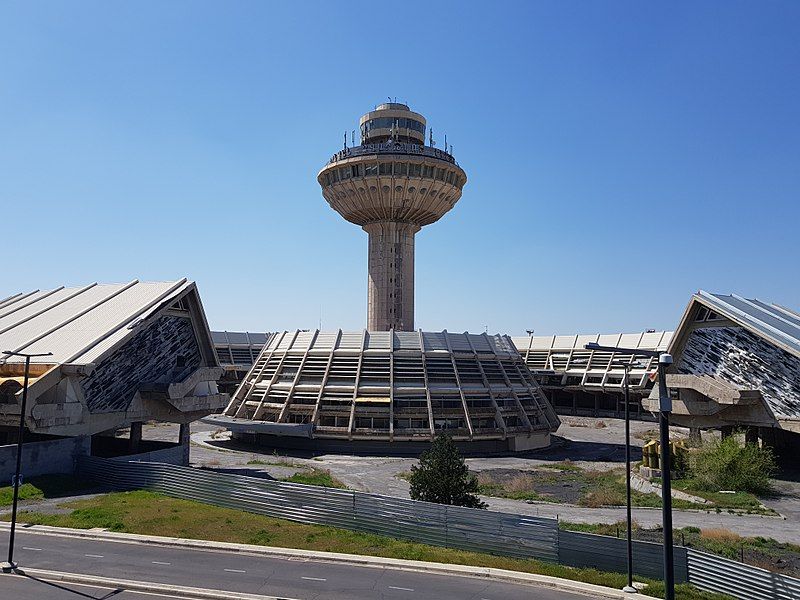
Another example of the local embracement of Soviet-era architecture is Zvartnots International Airport's abandoned Terminal One and its central air traffic control tower. Built in the 1980s to accommodate the Soviet Union's increased domestic travel demands, the circular terminal is considered a prime example of Soviet Modernism and an important 20th century monument. The control tower rising up from its center is a popular image for postcards and brochures. After closing permanently in 2011 and a multi-year battle to save it, the terminal itself—which resembles an Armenian version of Disney's Space Mountain—is unfortunately slated for demolition later this year. However, the tower will remain standing.
Byurakan Astrophysical Observatory (BAO), Mount Aragats
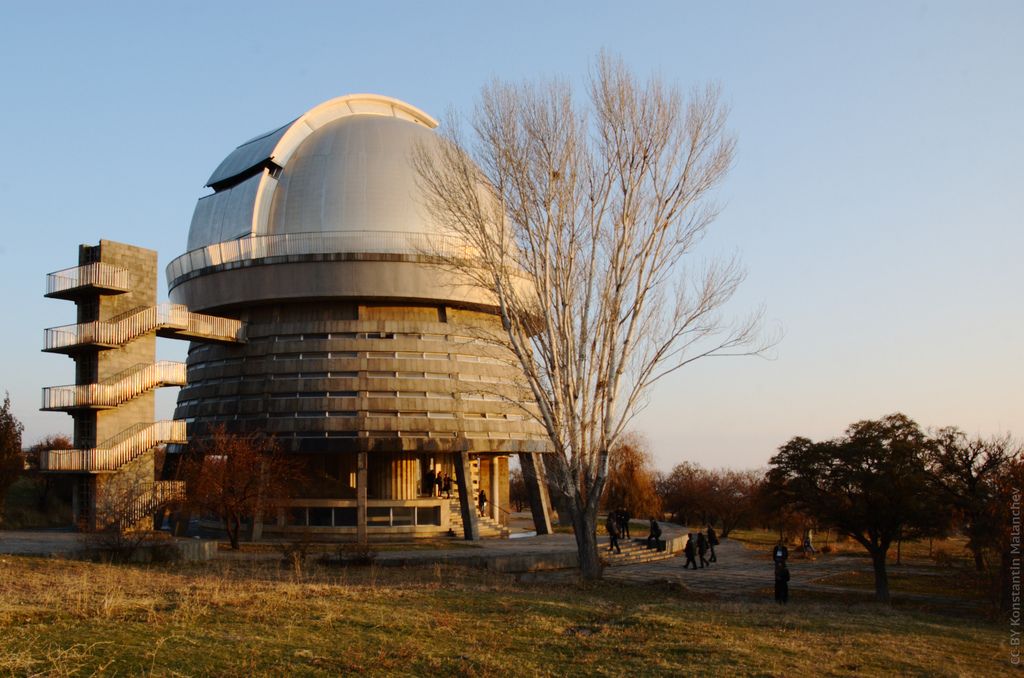
One of the U.S.S.R.'s most renowned astronomy centers sits on the southern slope of 13,420-foot-tall Mt. Aragats, tucked away among farmers and goat herders near the tiny village of Byurakan in the Armenian Highlands. Honored Soviet Union architect Samuel Safarian designed the Soviet-style observatory's structures and campus—opened in 1946—which include its rounded astronomy towers, laboratory buildings, and even a small guesthouse. In 1971, BAO hosted a Soviet-American conference dedicated to communicating with extraterrestrials: an event that attracted everyone from MIT's AI laboratory co-founder Marvin Lee Minsky to co-organizer Carl Sagan. The observatory is still active and open to visitors.
Sanatoriums, Jermuk
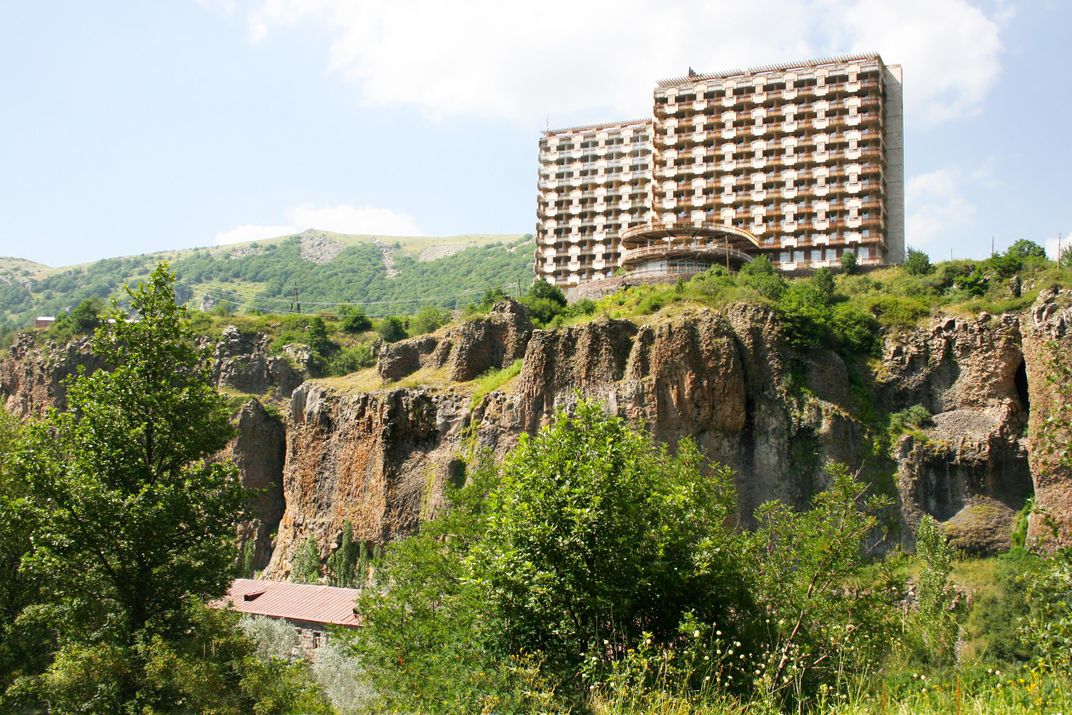
Known as much for its Soviet-era architecture as it is for its reported healing mineral waters, the mountain town of Jermuk in southern Armenia's Vayots Dzor Province was one of Armenia's most popular Soviet resorts in the 1970s and '80s. Despite a wave of new development, many of its original sanatoriums and buildings from the 1950s and '60s remain, albeit in various states of repair. These include the stark Jermaine Ashkharh sanatorium (1975), the towering Gladzor Sanatorium and the classical-style Olympia Sanatorium (1958)—all still in operation—and abandoned sites like a waterside sports and cultural center and a rusted-out cliffside hotel.
Planning Your Next Trip?
Explore great travel deals
Smithsonian magazine participates in affiliate link advertising programs. If you purchase an item through these links, we receive a commission.
/https://tf-cmsv2-smithsonianmag-media.s3.amazonaws.com/accounts/headshot/LauraKiniry.png)
/https://tf-cmsv2-smithsonianmag-media.s3.amazonaws.com/accounts/headshot/LauraKiniry.png)